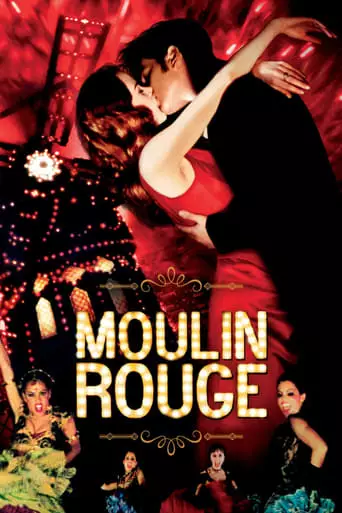A celebration of love and creative inspiration takes place in the infamous, gaudy and glamorous Parisian nightclub, at the cusp of the 20th century. A young poet, who is plunged into the heady world of Moulin Rouge, begins a passionate affair with the club’s most notorious and beautiful star.
Moulin Rouge! (2001), directed by Baz Luhrmann, is a vibrant musical that intertwines romance, tragedy, and artistic expression. Set in 1899 Paris, the film follows Christian, a young Scottish writer who moves to the bohemian Montmartre district. He becomes enamored with Satine, the star courtesan of the Moulin Rouge cabaret. Their love story unfolds amidst the cabaret’s extravagant performances and the looming threat of financial ruin. The narrative explores themes of love, sacrifice, and the pursuit of artistic dreams.
Analysis
Baz Luhrmann’s direction is characterized by a dynamic visual style, blending contemporary music with the historical setting to create a unique cinematic experience. The film’s use of modern songs reimagined in a period context adds a layer of anachronistic flair, enhancing its emotional resonance. The performances, particularly by Nicole Kidman as Satine and Ewan McGregor as Christian, are compelling, capturing the depth and complexity of their characters’ emotions. The film’s production design, including elaborate costumes and set pieces, contributes to its immersive and fantastical atmosphere.
Main Themes
- Love and Sacrifice: The central theme revolves around the transformative power of love and the sacrifices it entails. Christian and Satine’s relationship exemplifies the idealistic notion of love transcending societal constraints, yet their love is marred by the harsh realities of their circumstances.
- Artistic Expression and Bohemian Ideals: The film celebrates the bohemian lifestyle, emphasizing the pursuit of art and beauty above material wealth. The characters’ dedication to artistic expression, despite financial and personal challenges, underscores the film’s message about the importance of following one’s artistic passions.
- Illusion vs. Reality: Moulin Rouge! explores the tension between illusion and reality, particularly within the cabaret setting. The dazzling performances and vibrant visuals contrast with the underlying struggles and tragedies of the characters, highlighting the escapism offered by art and the harsh truths it often conceals.
- Social Class and Aspiration: The narrative delves into themes of social mobility and aspiration, portraying characters striving to transcend their social standings. Christian’s journey from a penniless writer to a successful playwright reflects the desire for recognition and the challenges of achieving one’s dreams within a stratified society.
Impact of the Movie
Upon its release, Moulin Rouge! received critical acclaim for its innovative storytelling, direction, and performances. It garnered eight Academy Award nominations, including Best Picture and Best Actress for Nicole Kidman, winning two for Best Art Direction and Best Costume Design. The film’s unique blend of musical genres and visual style has influenced subsequent musicals and remains a significant work in the genre. Its success led to a stage adaptation, further cementing its cultural impact.
7 Reasons to Watch Moulin Rouge! (2001)
- Innovative Direction and Visual Style:
Baz Luhrmann’s direction brings a fresh and dynamic approach to the musical genre. His use of rapid editing, vibrant color palettes, and imaginative set designs creates a visually stunning experience that captivates the audience from start to finish.
- Compelling Performances:
Nicole Kidman delivers a powerful portrayal of Satine, capturing the character’s complexity and vulnerability. Ewan McGregor’s performance as Christian is equally compelling, showcasing his versatility and emotional depth. Their chemistry adds authenticity to the central love story.
- Eclectic and Engaging Soundtrack:
The film features a unique soundtrack that blends contemporary pop and rock songs with the traditional musical score. This fusion not only enhances the emotional impact of the scenes but also introduces classic songs to a new audience in a fresh context.
- Stunning Production Design and Costumes:
The elaborate set designs and intricate costumes transport viewers to the opulent world of the Moulin Rouge. The attention to detail in the production design creates an immersive environment that enhances the storytelling.
- Emotional Depth and Storytelling:
The narrative weaves themes of love, sacrifice, and artistic ambition into a poignant story. The emotional journey of the characters resonates deeply, leaving a lasting impression on the audience.
- Cultural and Artistic Significance:
Moulin Rouge! pays homage to the rich history of cabaret and musical theater. Its artistic approach and homage to the bohemian ideals of the late 19th century offer a glimpse into a vibrant cultural era.
- Timeless Appeal:
Despite being set in the past, the film’s themes of love, passion, and artistic expression are timeless. Its universal messages continue to resonate with audiences, making it a classic in the musical genre.
How Will You Feel After Watching Moulin Rouge! (2001)?
After watching Moulin Rouge! , you may experience a mix of exhilaration and poignancy. The film’s vibrant visuals and energetic musical numbers are likely to leave you feeling uplifted and entertained. However, the underlying themes of love, sacrifice, and the pursuit of artistic dreams may evoke a sense of melancholy and reflection. The tragic elements of the story, combined with the characters’ deep emotional journeys, can lead to a bittersweet aftertaste, prompting contemplation about the nature of love and the sacrifices it entails. Overall, the film offers a rich and emotionally resonant experience that lingers long after the credits roll.

